
Help Cure Muscular Dystrophy is a volunteer computing project that runs on the BOINC platform.
It is a joint effort of the French muscular dystrophy charity, L'Association française contre les myopathies; [1] and L' Institut de biologie moléculaire et cellulaire (Molecular and Cellular Biology Institute).
Project purpose
Help Cure Muscular Dystrophy studies the function of various proteins that are produced by the two hundred genes known to be involved in the production of neuromuscular proteins by modelling the protein-protein interactions of the forty thousand relevant proteins that are listed in the Protein Data Bank. More specifically, it models how a protein would be affected when another protein or a ligand docks with it. [2]
Scientific publications
- Decrypting protein surfaces by combining evolution, geometry, and molecular docking. Proteins: Structure, Function, and Bioinformatics (2019). [3]
- Hidden partners: Using cross-docking calculations to predict binding sites for proteins with multiple interactions. Proteins: Structure, Function, and Bioinformatics (2018). [4]
- Protein social behavior makes a stronger signal for partner identification than surface geometry. Proteins: Structure, Function, and Bioinformatics (2017). [5]
- Great interactions: How binding incorrect partners can teach us about protein recognition and function. Proteins: Structure, Function, and Bioinformatics (2016). [6]
- Protein-Protein Interactions in a Crowded Environment: An Analysis via Cross-Docking Simulations and Evolutionary Information. PLOS Computational Biology (2013). [7]
- From Dedicated Grid to Volunteer Grid: Large Scale Execution of a Bioinformatics Application. Journal of Grid Computing (2009). [8]
- Joint Evolutionary Trees: A Large-Scale Method To Predict Protein Interfaces Based on Sequence Sampling. PLOS Computational Biology (2009). [9]
- Identification of Protein Interaction Partners and Protein–Protein Interaction Sites. Journal of Molecular Biology (2008). [10]
See also
References
- ^ "French Muscular Dystrophy Association". Archived from the original on 2009-12-01. Retrieved 2009-10-30.
- ^ "Help Cure Muscular Dystrophy - Phase 2 | Research | World Community Grid". www.worldcommunitygrid.org. Retrieved 2022-09-10.
- ^ Dequeker, Chloé; Laine, Elodie; Carbone, Alessandra (November 2019). "Decrypting protein surfaces by combining evolution, geometry, and molecular docking". Proteins: Structure, Function, and Bioinformatics. 87 (11): 952–965. doi: 10.1002/prot.25757. ISSN 0887-3585. PMC 6852240. PMID 31199528.
- ^ Lagarde, Nathalie; Carbone, Alessandra; Sacquin-Mora, Sophie (July 2018). "Hidden partners: Using cross-docking calculations to predict binding sites for proteins with multiple interactions". Proteins: Structure, Function, and Bioinformatics. 86 (7): 723–737. doi: 10.1002/prot.25506. PMID 29664226. S2CID 4900895.
- ^ Laine, Elodie; Carbone, Alessandra (January 2017). "Protein social behavior makes a stronger signal for partner identification than surface geometry: Protein Social Behavior". Proteins: Structure, Function, and Bioinformatics. 85 (1): 137–154. doi: 10.1002/prot.25206. PMC 5242317. PMID 27802579.
- ^ Vamparys, Lydie; Laurent, Benoist; Carbone, Alessandra; Sacquin‐Mora, Sophie (October 2016). "Great interactions: How binding incorrect partners can teach us about protein recognition and function". Proteins: Structure, Function, and Bioinformatics. 84 (10): 1408–1421. doi: 10.1002/prot.25086. ISSN 0887-3585. PMC 5516155. PMID 27287388.
- ^ Lopes, Anne; Sacquin-Mora, Sophie; Dimitrova, Viktoriya; Laine, Elodie; Ponty, Yann; Carbone, Alessandra (2013-12-05). Kann, Maricel (ed.). "Protein-Protein Interactions in a Crowded Environment: An Analysis via Cross-Docking Simulations and Evolutionary Information". PLOS Computational Biology. 9 (12): e1003369. Bibcode: 2013PLSCB...9E3369L. doi: 10.1371/journal.pcbi.1003369. ISSN 1553-7358. PMC 3854762. PMID 24339765. S2CID 5880229.
- ^ Bertis, Viktors; Bolze, Raphaël; Desprez, Frédéric; Reed, Kevin (December 2009). "From Dedicated Grid to Volunteer Grid: Large Scale Execution of a Bioinformatics Application". Journal of Grid Computing. 7 (4): 463–478. doi: 10.1007/s10723-009-9130-7. ISSN 1570-7873. S2CID 22791104.
- ^ Engelen, Stefan; Trojan, Ladislas A.; Sacquin-Mora, Sophie; Lavery, Richard; Carbone, Alessandra (2009-01-23). Levitt, Michael (ed.). "Joint Evolutionary Trees: A Large-Scale Method To Predict Protein Interfaces Based on Sequence Sampling". PLOS Computational Biology. 5 (1): e1000267. Bibcode: 2009PLSCB...5E0267E. doi: 10.1371/journal.pcbi.1000267. ISSN 1553-7358. PMC 2613531. PMID 19165315. S2CID 12292219.
- ^ Sacquin-Mora, Sophie; Carbone, Alessandra; Lavery, Richard (October 2008). "Identification of Protein Interaction Partners and Protein–Protein Interaction Sites". Journal of Molecular Biology. 382 (5): 1276–1289. doi: 10.1016/j.jmb.2008.08.002. PMID 18708070.
External links